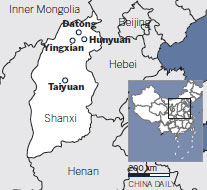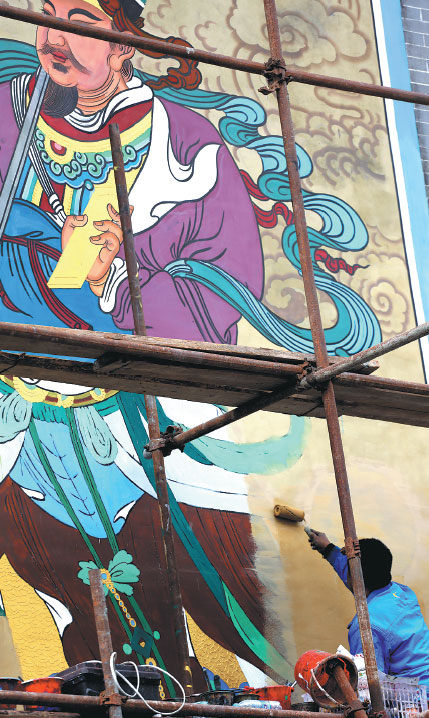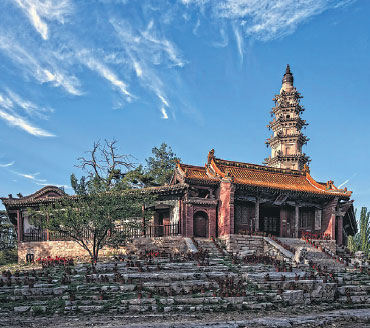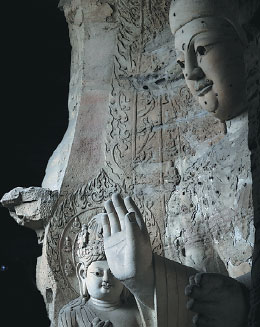Mining rich seams of cultural heritage
Datong, once associated with coal and pollution, is cleaning up its act and embracing its rich history in a bid to attract tourists and diversify its economy, Jean-Louis Turlin discovers.
The broad paved alley leading to the Yungang Grottoes is bordered with huge sculpted pillars that cut through a nascent forest of pine and silver birch trees - a heavenly and peaceful site indeed.
But beyond this green carpet, the abandoned aerial tracks of a nearby coal mine remain as a symbol of the conflicting images of an area that is to this day known for its industrial present as much as for its cultural past.
In fact, it may be the future of China that is being shaped in and around Datong, the second-largest city in Shanxi province and home to more than 700,000 people. It is 275 kilometers north of the capital, Taiyuan, which has a population of 4.3 million.

Unlike Shaanxi, its neighbor to the west, from which it is separated by the Yellow River, Shanxi - with a single "a" - has not so far featured too prominently on international tourist maps. But that might now be changing.
Traces of human settlements dating back as far as 2,300 years BC (the Taosi site in Xiangfen county), huge mountains that once served as a deterrent against invaders from the north, and remnants of the inner Great Wall along the border with Inner Mongolia, are there to remind us that Shanxi province has been rightly considered both the birthplace and the fortress of China.
It is home to archaeological, architectural, artistic and religious treasures that local experts have seemed determined to restore since the beginning of reform and opening-up. To that end, 1.7 billion yuan ($253.2 million) has been allocated to different projects this year - and to protect such treasures from environmental hazards.
Take the Yungang Grottoes, for example. This Buddhist splendor, listed in 2001 as a UNESCO World Heritage Site, contains 51 grottoes sheltering more than 50,000 images and sculptures carved in the sandstone hills 16 km from Datong, with over 5,100 statues of the Buddha that range in height from a few centimeters to 17 meters.
Up to 40,000 laborers and sculptors toiled over digging the caves in the flank of the hill and chiseling furiously to create an open-air museum. Work on the museum was started by the Buddhist monk Tanyao during the Northern Wei Dynasty (386-534) and completed over the following two dynasties.
In modern times, however, the neighboring coal mine and the railroad leading freight trains to and from it became both a nuisance and a threat.
The mine has been shut down "for now", explained a local official who preferred to remain anonymous, and rail traffic, "which made the earth shake", has been reduced to two trains a day.
"There was no other choice," he said, quoting many examples of private mines being either closed down or incorporated into State mining companies, thus "making it possible to enforce industry standards in terms of human safety and environmental protection".
Known for its superior quality, the coal produced in Shanxi, the largest coal-supplying province in the country, was in great demand during the unusually cold winter in southern China in 2008.
The province is now implementing coal conversion projects, through which coal will be converted into gas, which is cleaner and more environment-friendly. Technological research is also exploring the potential use of coal residue in textiles and other materials.
Because of this, both universities and industrial companies are now involved in applied research aiming at economic diversification. The province has created a specific bureau devoted to light industry. However, "research centers are still lacking funding", the local official said. When it comes to economic diversity, tourism is an obvious priority.
Magnificent landscape
Shanxi, a province of 36 million people, three times the size of the Netherlands, 350 km west of Beijing and three hours from the capital by high-speed rail, has a lot to offer, boasting more than 70 percent of the country's well-preserved ancient buildings from periods preceding the Song Dynasty (960-1279) and three World Heritage sites (the Wutai Mountains in Xinzhou, Pingyao Ancient Town in Jinzhong and the Yungang Grottoes in Datong).
In the face of such cultural and geographic marvels, Datong's title as "China's Coal City" seems unfair, especially as the city is in the process of consigning its coal-producing days to the past.
This former garrison town honors its Ming Dynasty (1368-1644) period with its nightly illuminated wall and towers, as well as its Nine-Dragon Screen, which is older than the one in the Forbidden City in Beijing, and it is surrounded by many other wonders besides the Yungang Grottoes.
We can find, for instance, the Yingxian Wooden Pagoda, which was built in the 11th century using no nails and still stands 67.31 meters high.
Or the Great Wall at Yanmen Pass, "the first pass of China" to Inner Mongolia. Or the extraordinary Hanging Temple in Hunyuan, which sticks out of the side of Hengshan Mountain 75 meters from the ground.
The blue sky that welcomed us in Datong was a strong refutation of the "Coal City" epithet. Much has been done there and throughout the province to improve the environment.
On witnessing the large-scale, local tree-planting projects, "I can now feel the beauty, the peace and harmony of the city", said Chen Di, a 26-year old female resident of Datong. This push toward harmony and environmental balance is also reflected in the electric golf carts used in the province's mines or the electric and hybrid taxis and motorcycles that are conspicuous in Taiyuan and other cities.
"Shanxi is perhaps the oldest and most traditional of all the provinces and is least affected by Western influences," said Ted Mason, an Englishman who has been living in Taiyuan for five years.
Tourists appreciate these elements of tradition and uniqueness: Almost 1.5 million of them visit the Hanging Temple each year. They are still mostly Chinese, but, if foreign visitors follow suit, the province's tourism industry might see its growth rate climb significantly from last year's figure of 21.1 percent.
The author is an editor at China Watch, a publication by China Daily.
|
A worker paints an ancient fi gure on a wall in Datong. The city has shed its reputation as a polluted mining center and is now celebrated for both its harmonious development and rich cultural heritage. Li Jin / China Daily |
|
The Water Goddess Temple, built in 1526, has an array of well preserved structures. Attila Balogh / For China Daily |
|
A snapshot of the Yungang Grottoes in Datong. Li Jin / China Daily |
(China Daily 10/19/2016 page6)

















